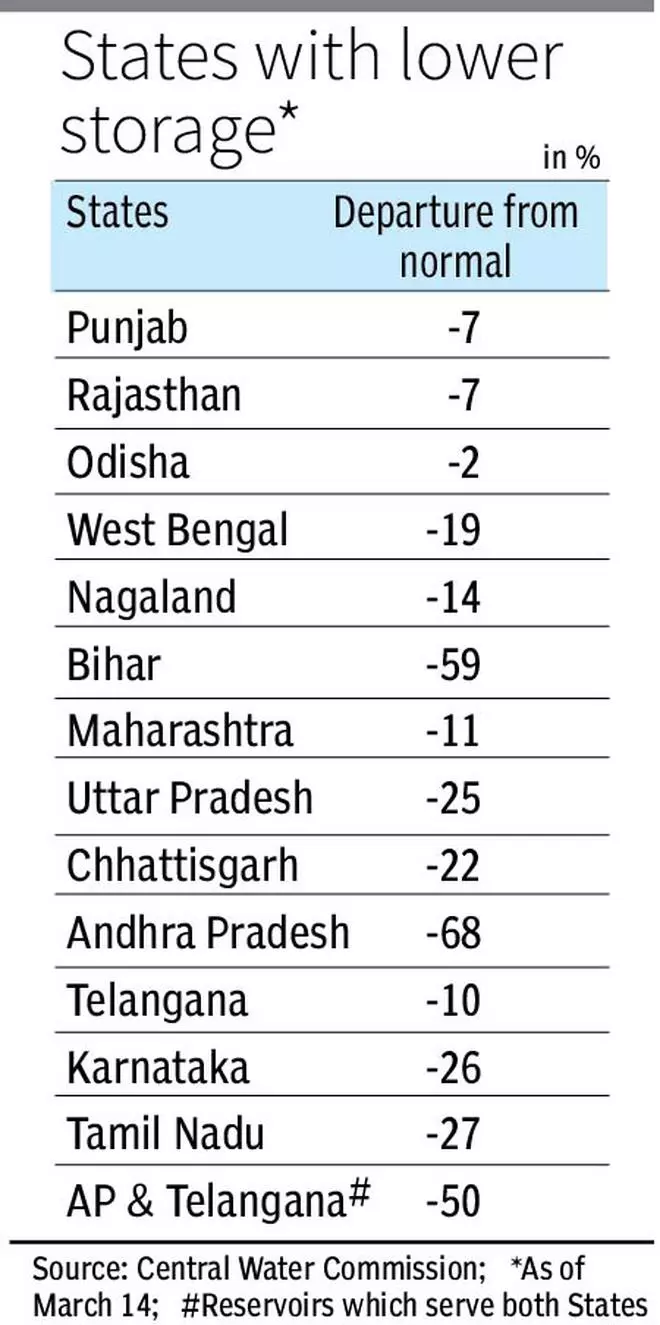

A file photo of partially dried-up Vainganga river which supplies water to entire Gadhchiroli dist, Maharashtra | Photo Credit: PRASHANT NAKWE
The water level in half of India’s 150 major reservoirs is less than 40 per cent of the capacity with the storage in two-thirds being less than 50 per cent, as per data from the Central Water Commission (CWC) on Thursday.
The major reason for the low storage is that under the influence of El Nino, which results in drought and prolonged dry period in Asia due to the warming up of the Pacific Ocean, at least 60 per cent of the country received deficient or no rainfall since January this year. Even during the post-monsoon period of October-December 2023, over 50 per cent of the country received deficient rainfall.
According to CWC’s weekly bulletin on live storage status of 150 reservoirs, the water level this week was 40 per cent of the 178.784 billion cubic metres (BCM) capacity at 70.746 BCM. During the same period a year ago, the level was 84 per cent of the capacity. Over the last 10 years, the average water level has been 97 per cent of the capacity. It is for the 23rd consecutive week that the water level has declined.

While the level in 75 of the reservoirs is below 40 per cent of the capacity, it is below 50 per cent in 21 and below 60 per cent in 32 others — cause for worry as the storage continues to dip in the face of lack of rainfall.
The situation in the southern region is more concerning with cities such as Bengaluru already starved of water. In fact, Karnataka, where the storage is 26 per cent below normal, has been rain deficient ever since El Nino emerged in June 2023.
Also read: Bengaluru’s thirst: Delving into the complexities of the silicon city’s water crisis
Nearly three-fourths (30) of the 42 reservoirs in the region are filled below 40 per cent of the capacity and a few more could witness a decline over the next couple weeks.
Andhra Pradesh (-68 per cent) tops among States where the reservoir level is below normal. The storage in Tamil Nadu is 27 per cent lower than usual, while in Telangana it is 10 per cent lower. Kerala’s level is normal but chances are that it could drop next week.
Srisailam (15 per cent of capacity), Nagarjuna Sagar (4 per cent), Somasila (8 per cent), Yeluru (1 per cent) and Kandaleru (7 per cent), Priyadarshini Jurala (2 per cent) and Kaddam (4 per cent) in Andhra Pradesh and Telangana have low storage.
In Karnataka, the level in Krishnaraja Sagara (16 per cent), which irrigates the Cauvery delta, Tungabhadra (4 per cent) — which irrigates crucial cereals-growing areas of Uttara Karnataka, Telangana and Andhra Pradesh — and Narayanpur (17 per cent) is worrisome.
In Tamil Nadu, Aliyar (8 per cent) and Sholayar (3 per cent), which irrigate the key agricultural areas in the western parts, storage is low. Overall, the storage in the southern region is 24 per cent of the 53.334 BCM capacity at 13.054 BCM.
Though the storage in the northern region dropped to 34 per cent of the 19.663 BCM capacity (39 per cent same time a year ago) at 6.744 BCM, it can expect relief once the snow in the Himalayas begins to melt. An agriculture expert said in contrast, the southern region may not have any relief until the South-West monsoon sets in June.
In both Punjab and Himachal Pradesh, the storage is 7 per cent lower than normal. Barring one, the level in 9 of the 10 reservoirs in the northern region is below 50 per cent of the capacity.
Of the 23 reservoirs in the eastern region, the storage this week was 50.7 per cent of 20.430 BCM capacity at 10.363 BCM. Of these, 11 are filled less than half the capacity. Assam has more than double the normal storage, while it is 59 per cent below normal in Bihar.
In the western region, 25 of the 49 reservoirs have a level below 50 per cent of the capacity. Overall, the storage was 48 per cent of the 37.130 BCM capacity at 17.815 BCM.
In the central region, the level in 17 of the 26 are below 50 per cent of the capacity. Of the 48.227 BCM capacity, the storage was 22.77 BCM or 47 per cent. Chhattisgarh (-22 per cent) and Uttar Pradesh (-25 per cent) had below normal water.
Published on March 14, 2024

Comments
Comments have to be in English, and in full sentences. They cannot be abusive or personal. Please abide by our community guidelines for posting your comments.
We have migrated to a new commenting platform. If you are already a registered user of TheHindu Businessline and logged in, you may continue to engage with our articles. If you do not have an account please register and login to post comments. Users can access their older comments by logging into their accounts on Vuukle.